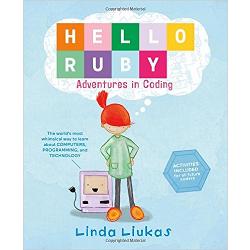
Ruby is a small girl with a huge imagination. When her father goes on a business trip, he leaves her a postcard saying he has hidden five gems for her to find. During her adventure to find the gems, Ruby is introduced in a playful way to the basic concepts of coding and programming.
This, in short, is the story of the children’s book "Hello Ruby: Adventures in Coding," written and illustrated by Finnish author Linda Liukas.
In 2014, Liukas raised a stunning $ 380,000 on Kickstarter to realize her dream of educating children in the field of computing. The book appeared at the end of 2015 in English, Finnish, and Swedish, and this year has come out in several more languages.
Liukas is also co-founder (with designer Karri Saarinen) of Rails Girls, a platform aimed at teaching the basics of programming to young women all over the world.
Just after the Dutch translation of ‘Hello Ruby’ was released, I met with the energetic and cheerful Finnish author in an Amsterdam hotel. Following are parts of our discussion:
Bennie Mols: How many impossible things have you believed before today’s breakfast?
Linda Liukas: I went to run before breakfast. Running for me is the meditation when I don’t think about anything. So, today I haven’t believed a single impossible thing before breakfast. But the impossible thing that I recently dreamed about is transforming a container into a huge computer. The idea is that children can crawl inside it and, through tactile play, learn about the different abstraction levels of computing: zeros and ones, logical gates, architectural levels, operating systems and so on.
The background of this project is that I am a bit jealous on the generation of the Sixties and Seventies. People from these generations had a physical relation to the technology of computers; they could take things apart and put them back together again. I would like to bring a little bit of this anarchy back in the way children deal with computing.
BM: Why is it important for children to learn about ‘computational thinking?’
LL: Our world is increasingly run by software, so I basically would like to prepare kids for a world in which everything will be a computer. In my book I first tell a story, and in the second part I explain how Ruby’s skills to solve problems in the story can be used to think about how a computer can solve problems: by abstracting and dividing a problem into sub-problems, by thinking logically and discovering patterns and algorithms.
Additionally, I want to teach kids that the world is not ready, that technology is a wonderful way to make the world a bit better and that they can be part of that change.
BM: You say that there are two sides to programming: the intellectual side and the creative side. How can we teach the creative side to kids?
LL: I think the teaching should be more based on context. This summer, we are going to organize a summer school in Finland where we will consider the example of recycling. What is recycling? How can computers help us with it? What should a computer know to sort waste? Which types of sorting algorithms exist? We will be exploring all these questions by playing outside. We will show that there are different strategies for sorting data, and involve a company that turns trash bins into computers. I think we need these types of concrete examples.
BM: Can you tell some anecdotes of how children are inspired by your teaching of computational thinking?
LL: I asked kids to write down on a piece of paper what technology is. A nine-year-old girl wrote, "Technology is electricity that loves." A beautiful, poetic answer. She also wrote, "people use technology. That generation totally gets it; they are not afraid of artificial intelligence taking over the world.
A funny anecdote is about a boy who asks his parents to only pose questions in a form that can be answered with "true" or "false," like a computer could does. So, instead of his parents asking him "How was kindergarten today?" he has them say, "Kindergarten was nice today," to which he then could reply, "yes."
When discussing with kids the possibilities of turning everyday objects into computers, one boy came up with the idea of transforming a bicycle lamp into a movie projector.
BM: Which prominent figures from computer science have inspired you?
LL: I am most inspired by the visions from the 70’s of (ACM A.M. Turing Award recipients) Alan Kay and Douglas Engelbart. For them, computers were a way of dreaming a better future. I think we have forgotten this optimism, and I would like to bring it back.
Bennie Mols is a science and technology writer based in Amsterdam, the Netherlands



Join the Discussion (0)
Become a Member or Sign In to Post a Comment